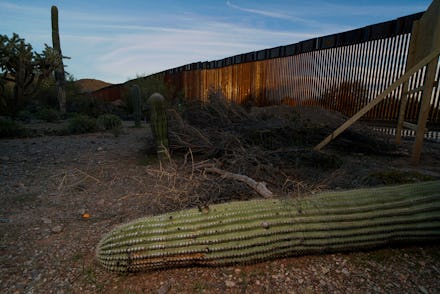Trump's wall is threatening at least 8 endangered species, according to government emails

Staffers at the U.S. Fish and Wildlife Service (FWS) have been sending urgent emails sounding the alarm, at least internally, about the disastrous impact of Trump's border wall on wildlife. The emails, obtained by The Center for Biological Diversity and shared with Earther, show the agency's worry that construction of the border wall is harming the habitat of at least 8 endangered species in Arizona.
The wall runs through the state's San Bernadino Wildlife Refuge, where the animals and fish greatly depend on water in ponds and wetlands to survive the desert heat. According to the emails, however, the construction is draining water from the ponds' source to mix concrete for the wall and control dust levels, leaving the ponds in the refuge dry.
Usually, construction crews have to abide by certain regulations to minimize the impact on the environment. But the Department of Homeland Security has been issuing "environmental waivers" to expedite the construction of portions of the wall, which means the crews can do whatever they want to get the barriers up.
Apparently, this includes destroying national monuments, bulldozing protected saguaro cacti, and desecrating culturally sacred sites and native-owned land.
In the emails, FWS staff reported salvaging fish out of dried ponds and creating additional plans to save the endangered fish species in the wildlife refuge.
"We are hoping for the best, but are planning for the worst," refuge manager Bill Radke wrote in an email to his team. "We are developing/implementing contingency plans to protect at least a subset of the endangered fish population that once thrived on the refuge."
The construction team is reportedly using 700,000 gallons of water per day from the San Bernadino Valley for concrete and dust. Laiken Jordahl, a campaigner with the Center for Biological Diversity (CBD), didn't mince words in a comment to Earther.
"We're talking about the most valuable natural resource in the desert just being pissed away to suppress dust for construction activity," Jordahl said. "That shouldn't be happening in the first place."
Scientists and conservationists have tried to raise awareness of the sheer amount of environmental damage the border wall would create in the region. The wall also threatens to disrupt migration routes that are important for wild rams and wolves along the border. But their protests and cries have fallen on unsympathetic ears.
In December 2019, Radke wrote to his team to inform them that the construction crew's act of pulling water from the refuge's primary water source was "the current greatest threat to endangered species in the southwest region."
It's a depressing and outrageous thought made all the more upsetting by the Trump administration's callousness.
"This administration's cruelty knows no bounds," Jordahl told Earther. "In terms of the urgency that you see in those emails, that goes to show that we've got all these agency scientists and professionals who have been doing everything they can to sound the alarm, but they have been ignored, stonewalled, and just cut out of the process."